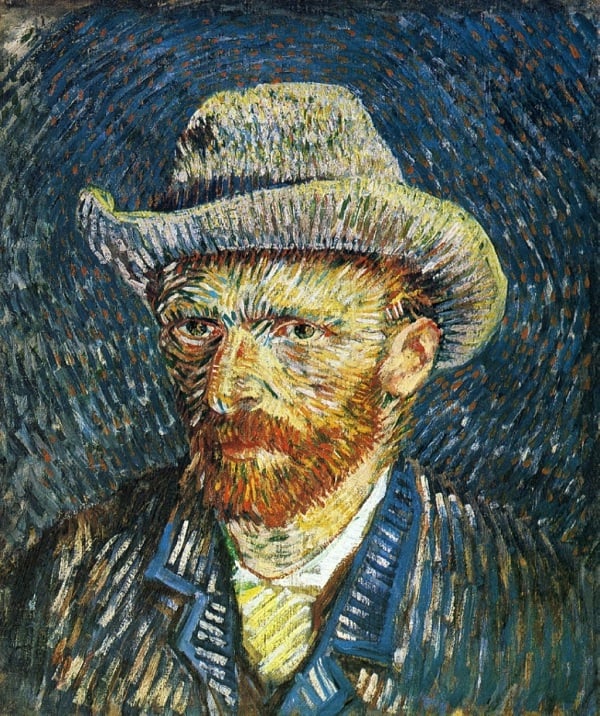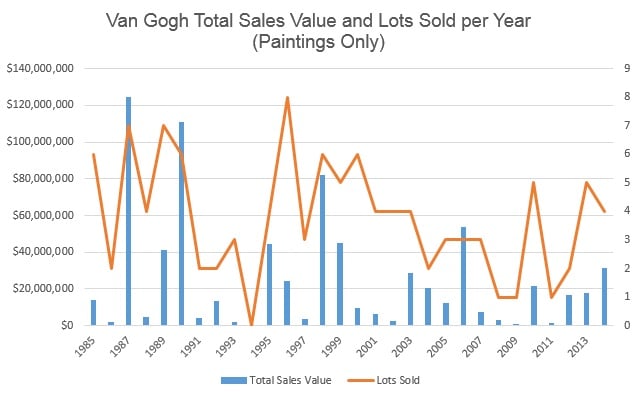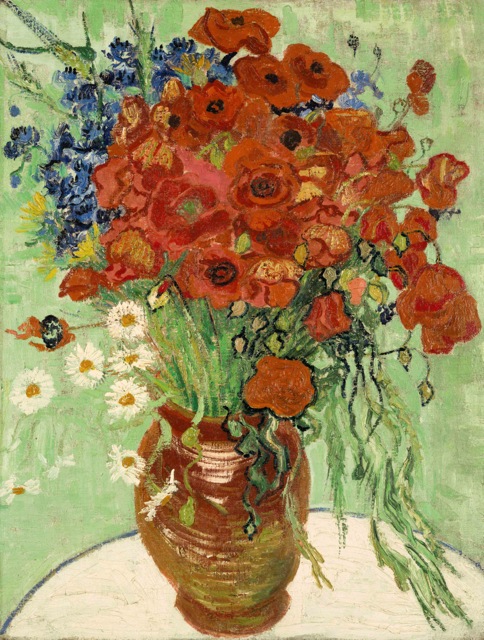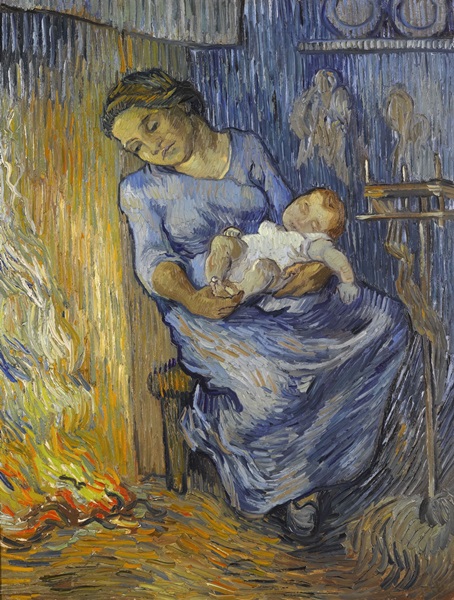Analysis
Do Riches Await in the Van Gogh Auction Market?
An erratic auction market has been driven by global demand and eccentric billionaires.

An erratic auction market has been driven by global demand and eccentric billionaires.


Source: artnet Analytics
A key highlight of Sotheby’s evening Impressionist and modern art sale next month is a rare Vincent Van Gogh still life with an estimate of $30–50 million. Sotheby’s calls Still Life, Vase with Daisies and Poppies (1890) “the most important still life by Van Gogh to appear at auction in more than two decades” and Simon Shaw, co-head of the Impressionist and modern art department worldwide noted that the “beautiful, vibrant composition captures in sharp relief the intensity of the artist at the height of his mania, only weeks before his tragic end.”

Vincent van Gogh, Still Life, Vase with Daisies and Poppies (1890) is estimated at $30–50 million and will be included in Sotheby’s evening Impressionist and modern sale on November 4.
Photo: Courtesy Sotheby’s.
Certainly today’s booming global art market provides an appropriate backdrop for a bidding battle over this work. Few artist names resonate more with art lovers and collectors or have the kind of star power that can draw masses to museum and gallery shows. “The Van Gogh name is one of the few truly magic global names. It’s a name that resonates in Beijing as it does in London, San Francisco, and Kiev,” says Shaw.
Despite this, the Dutch artist has what is arguably one of the most erratic auction track records in the world, often rising and falling in tandem with broader collecting and economic trends. Compounding this is the relative scarcity of major works available, given the artist’s short, turbulent life and the fact that most works have already been snapped up for good by prestigious museums including the Van Gogh Museum in Amsterdam, the Art Institute of Chicago and the Museum of Modern Art in New York. Drawing on artnet Analytics data going back to 1985, we took a look at some of the highs and lows of this market.
The 1980s Art Market Boom
Van Gogh auction totals skyrocketed along with the broader art market, from $13.8 million in 1985 to $124.3 million in 1987, and then plummeted to $4.5 million in 1988. Van Gogh was among the artist names—along with Pierre Auguste Renoir—most closely associated with speculative buying by Japanese collectors.
In 1990, when an aggressive Japanese businessman named Ryoei Saito (who later ran into financial trouble and was arrested for bribing a politician over a property deal) shelled out a stunning $82.5 million for Van Gogh’s Portrait of Dr. Gachet, it became the most expensive painting ever sold at auction, a distinction it maintained for many years afterward. That year, auction volume for Van Gogh was $110.7 million. Four years later, in 1994, it was zero.
Scarcity of available works is also a major factor. For some of his Imp/mod sale contemporaries like the prolific Picasso, it is not unusual to see upwards of a half-dozen works in a major evening sale. The fact that major Van Goghs are so rare and so expensive often translates to huge swings in volume. In May 2006, Christie’s offered a portrait of Madame Ginoux, a proprietor of a local café in Arles that Van Gogh frequented during his stay there from 1888 to 1889. L’Arlésienne Madame Ginoux (1890) sold for $40.3 million, barely scraping the low end of the $40–50 million estimate but accounting for the lion’s share of the 2006 $53.5 million auction total, according to artnet Analytics. Three of four paintings offered that year found buyers.
The Economic Crisis Catches Up to the Art Market
In 2007, amid the height of the housing crisis and the broader downturn in the global economy, Sotheby’s had an expensive buy-in on its hands when The Fields (Wheat Fields) (1890) failed to find a bidder on its lofty estimate of $28–35 million. The total that year was a relatively slim $7.3 million for three works sold. (Sotheby’s confirmed that the work was later sold privately.) Conversely, one of the lowest totals on record was in 2000, when eight works came to auction. Of these, six were sold for a total of $9.5 million.
A Record Price for Irises…Or Not?
At times, the colorful characters involved with buying Van Gogh works have been as much a part of the story as the prices. In 1987, immediately on the heels of the massive October 1987 stock market crash, Australian financier Alan Bond paid $53.9 million for Van Gogh’s Irises (see “10 Game Changing Auctions.”). That year also marked the highest-ever overall volume of Van Gogh work sold at auction with $124 million, a level that has not been exceeded in a single year since, according to artnet Analytics.
When it was revealed nearly two years later that Sotheby’s had lent Bond about $27 million—roughly half the purchase price—and that Bond still wasn’t fully paid up, many observers deemed the $53.9 million price inflated and “manipulated.” They said it had inspired false confidence in the ability of the art market to withstand broader economic volatility. The painting was eventually snapped up for an undisclosed price by the J. Paul Getty Museum in Los Angeles, where it still hangs today.
The whereabouts of Dr. Gachet remain decidedly more mysterious. Ryoei Saito sparked outrage when he publicly proclaimed that he would be buried with Dr. Gachet as well as with Pierre Auguste Renoir’s Au Moulin de Galette (1876) which he paid $78.1 million for at Sotheby’s just two nights later. Dr. Gachet was reportedly eventually sold to Austrian financier Wolfgang Flottl, who also ran into his own financial difficulties. Dr. Gachet has not been seen in public since the 1990 Christie’s auction.
Meanwhile, Shaw said the upcoming still-life has been drawing interest from around the world, but notably interest from both mainland China and Hong Kong, as well as from Brazil, where growing ranks of newly wealthy buyers have embraced collecting. At the Sotheby’s London auction this past February of L’homme est en mer (1889) the painting sold for $27.5 million (£16.9 million), far higher than its $13 million high estimate—Shaw says other palpable factors contributing to its ultimate high price were global demand and an emphasis on the “best of the best.”

Van Gogh’s L’homme est en mer (1889) doubled its high estimate to sell for $27 million at Sotheby’s London this past February. Photo: Courtesy Sotheby’s